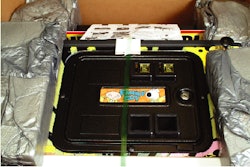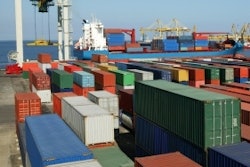
The purpose of distribution package testing hasn’t changed: to measure
the packaging’s ability to protect against the hazards of the
distribution environment. What has changed, though, is that the quest
for greener distribution packaging is mandating that testing be
performed with greater frequency and increased precision.
Greater frequency is a mandate stemming from a core concept of
sustainability, namely, that sustainability is never achieved
once-and-for-all, but rather is approached through constant,
incremental improvements. Distribution packaging (a.k.a. transit
packaging) is more than just a corrugated box and interior packing, for
example. It includes pallets, slip sheets, strapping, films, netting,
returnable containers---even methods of blocking and bracing within the
transportation vehicle. Any greener version of any component should be
tested for its effect on overall distribution packaging performance.
Sustainability and profitability
Increased precision is a mandate owed to the fact that sustainability
and profitability are dual, simultaneous pursuits; hence, the objective
of sustainable distribution packaging should be protection and overall
performance at optimal cost and at a level valued by the consumer. It
equates to increased revenues and reduce costs, and therefore to
increased profits.
Traditionally, distribution package testing has been performed less
frequently than testing associated with the design and function of the
primary package, the simple reason being that new or redesigned primary
packages come down the pike more frequently. By contrast, it’s common
for the same shipping box to accommodate a variety of primary packages.
The infrequency of distribution package testing is further attributable
to the practical benefits of standardization. Distribution packaging
should yield savings and efficiencies not only in transportation, but
also in material handling and storage. The dimensional and load-bearing
limitations operating in those three areas generally are accepted as
fixed, and the distribution packaging is designed around their
dictates. When distribution packaging elements—such as the shipping
box, pallet pattern, and unit load— efficiently utilize the
transportation mode, handling equipment, and storage facilities, those
elements are then standardized.
No damage, so why test?
As such, there’s a built-in disincentive to change the distribution
packaging, once a company believes that it has packaging that performs
reasonably well in that capacity. That translates to a disincentive to
conduct further distribution package testing. Additionally, some
companies don't test at all: Why incur unnecessary costs in the absence
of unacceptable damage levels?
Benefits exceeding costs is what every company wants whenever those two
factors are evaluated; however, regarding distribution testing, the
evaluation isn’t always carried out as far as it might be. A major
reason is that distribution packaging often is regarded as insurance
against the unknown contingencies of the distribution environment. The
thinking is, better to have a cushion (literally and figuratively),
especially in consideration of the loss of goodwill that damaged
shipments can produce.
Less is more
For years, the adage has been recited by graphic designers to convey
that a clean, uncluttered design communicates more effectively than one
that’s crowded. The phrase also lends itself to sustainability, the
idea being that less packaging means more eco-friendliness.
Consequently, even a company with a successful record of source
reduction will face constant pressures to achieve greater
sustainability.
Pressure from whom? A host of stakeholders, to be sure, but strong
among them is the retailer, as Wal-Mart’s initiatives in that regard
demonstrate. Retailer demand for less is not limited to disposal
preceding display. Selling from the pallet—the staple of club-store
merchandising—is also gaining presence in nonmembership venues. The
practice demands less distribution packaging, which not only
facilitates disposal, but also floor display and consumer access. And
regarding products that are retailed by the case, the distribution
package must not appear any worse for wear, since consumers are loath
to buy anything visibly blemished.
On the other hand, designers of distribution packaging long have had
their own take on the adage. To them, less packaging means more damage.
It’s true, of course, but only after a certain tipping point. Easy to
say; however, establishing that tipping point can be quite a challenge.
Compounding the challenge is that sustainability’s interpretation of
less is more applies to the primary package, too, conceivably making it
more in need of greater protection from its protective “big brother.”
Further complicating things is that many types of products are being
designed/redesigned for sustainability by reducing the amount of
materials in them. However, if the new design increases product
fragility, it places more demands on the distribution packaging. This
underscores the importance of fragility curves and designing the
product and packaging as an integrated whole.
In all, there are too many factors impacting distribution packaging to
know whether they’re being managed optimally, unless that knowledge
comes from a well devised and executed testing program. Companies that
presently don’t test ought to immediately start. Companies presently
testing ought to reevaluate their programs for areas for improvement.
The hazard of not knowing the hazards
The hazards are well known. They are of the physical variety: shock,
vibration, and compression. They are of the atmospheric variety:
temperature, moisture, and pressure. The knowledge too often in short
supply is the combination, intensities, and sequences of the hazards
encountered within a given distribution channel, without which it’s
impossible to design a distribution package testing protocol that will
yield accurate results.
The knowledge void can’t be filled by standardized laboratory tests,
such as those devised by ASTM (American Society of Testing Materials)
and ISTA (International Safe Transit Association). Such tests should be
calibrated to reflect known (or at least reasonably believed)
conditions; otherwise, the temptation is to set the parameters high, in
a willingness to err on the side of caution. The result is
over-packaging—not the best of outcomes in an era of sustainability.
The objective isn’t that the packaging survives the laboratory;
rather, the objective is that the packaging survives the distribution
environment. Logic, therefore, dictates that there be close similarity
between the conditions in the laboratory and in the field.
Some larger consumer packaged goods companies have their own testing
facilities, equipped with the likes of vibration tables, drop testers,
compression testers, (horizontal and inclined) impact testers, and
environmental chambers. Such CPG companies—just as with those that test
through for-hire laboratories—should strive to assure that the testing
reflects real-world conditions. Furthermore, these self-equipped
companies should avoid the trap of justifying their investments through
usage (as opposed to results), devising overly rigorous and complex
testing protocols that yield lots of data but not as much intelligence.
There, too, the likely consequence is over-packaging.
Field work
Field testing, also known as test shipping, should be the informational
source for designing a laboratory testing protocol, though reliance on
field testing to the exclusion of laboratory testing can be a
justifiable choice. At its simplest, field testing is observation and
manual recording. Observations and manual recordings memorialize the
occurrence of damage, but don’t reveal much more.
That limitation is overcome, in large measure, by the electronic field
data recorder, a small device placed inside a transportation vehicle,
either in or out of a shipping container. The device records physical
and atmospheric hazards and provides insights as to their intensities
and sequences. The data must be analyzed and given statistical
significance, before serving as input for designing a laboratory
testing protocol.
Speaking of statistics, there’s a determination to be made regarding
how many test shipments should be conducted before results are deemed
representative. The closest thing to a general rule is to test until
there is a discernable pattern.
A favorable trend
Sustainability has injected an unaccustomed dynamism to distribution
package testing, necessitating the ability to quickly and reliably
measure the performances of an increasing stream of green alternatives.
In turn, that ability relies on knowing the distribution environment in
increasingly greater detail. Fortunately, the trend toward supply
chain management can help.
Supply chain management, with its varied focuses on member relations,
shared information, security, and RFID—just to name a few—is resulting
in continual monitoring of products as they move throughout the
supply/distribution chain. At the various stops and junctures at which
data is collected, there are opportunities to creatively cull
information that bears upon the performance of green distribution
packaging. In all, a green supply chain is an umbrella under which
distribution packaging and its testing naturally fit.
As previously noted, sustainability and profitability are dual and
simultaneous pursuits. The word pursuit might be better substituted by
race, or even sprint, for competitive realities place a premium on
speed. Every operation should contribute to making the corporate track
shoes lighter and putting the wind at the corporation’s back. There’s
little practicality in speeding products to market in green
distribution packaging if the products arrive in unacceptable
condition. A testing program that provides speed and reliability in
determining the fitness of the distribution packaging is an asset worth
developing.
Before becoming a packaging consultant, Sterling Anthony worked for
Fortune 500 food, healthcare, and automotive companies, and has taught
packaging at the university level. He welcomes your comments by phone,
313/531-1875 or by e-mail, [email protected]. His Web site
is www.pkgconsultant.com.


























